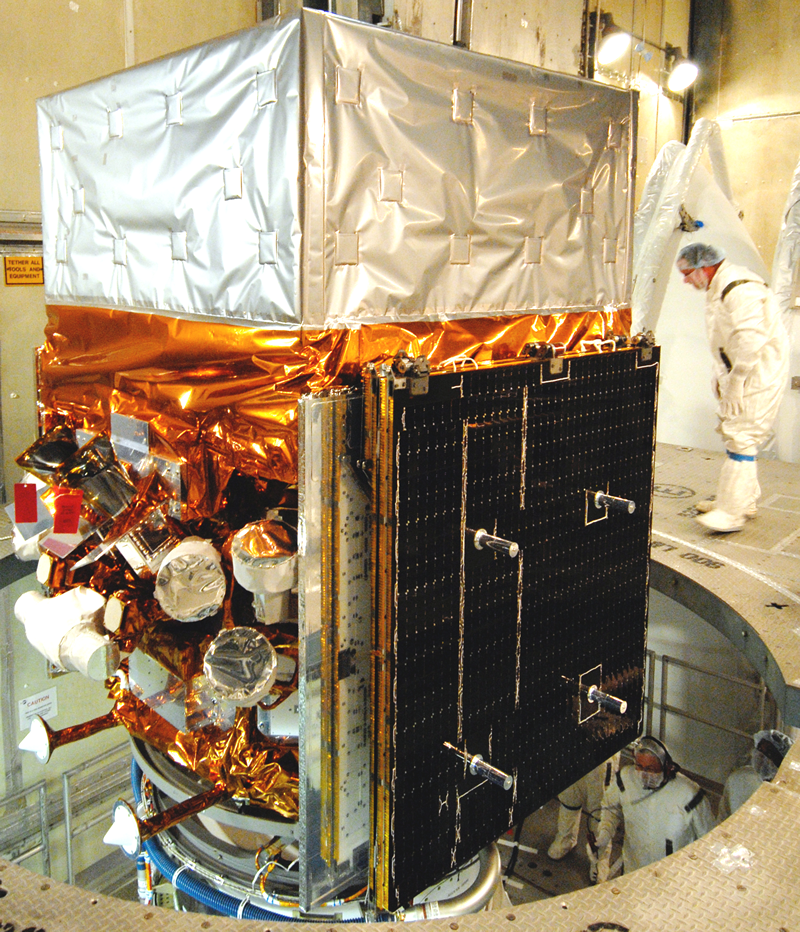Fermi LAT pictures
Click an image for a larger view
NASA's Astronomy Picture of the Day from the LAT Collaboration
Each image below links the relative NASA's Astronomy Picture of the Day (APOD) webpage.
Astronomy Picture of the Day April 29, 2016
Fermi's Gamma-ray Moon

Image Credit: NASA, DOE, International Fermi LAT Collaboration
Explanation: If you could only see gamma-rays, photons with up to a billion or more times the energy of visible light, the Moon would be brighter than the Sun! That startling notion underlies this novel image of the Moon, based on data collected by the Fermi Gamma-ray Space Telescope's Large Area Telescope (LAT) instrument during its first seven years of operation (2008-2015). Fermi's gamma-ray vision doesn't distinguish details on the lunar surface, but a gamma-ray glow consistent with the Moon's size and position is clearly found at the center of the false color map. The brightest pixels correspond to the most significant detections of lunar gamma-rays. Why is the gamma-ray Moon so bright? High-energy charged particles streaming through the Solar System known as cosmic rays constantly bombard the lunar surface, unprotected by a magnetic field, generating the gamma-ray glow. Because the cosmic rays come from all sides, the gamma-ray Moon is always full and does not go through phases. The first gamma-ray image of the Moon was captured by the EGRET instrument onboard the Compton Gamma-ray Observatory, launched 25 years ago.
Astronomy Picture of the Day July 22, 2015
Gamma-ray Rain from 3C 279

Video Credit: NASA, DOE, International Fermi LAT Collaboration
Explanation: If gamma-rays were raindrops a flare from a supermassive black hole might look like this. Not so gently falling on the Fermi Gamma-ray Space Telescope from June 14 to June 16 the gamma-ray photons, with energies up to 50 billion electron volts, originated in active galaxy 3C 279 some 5 billion light-years away. Each gamma-ray "drop" is an expanding circle in the time-lapse visualization, the color and maximum size determined by the gamma-ray's measured energy. Starting with a background drizzle, the sudden downpour that then trails off is the intense, high energy flare. The creative and calming presentation of the historically bright flare covers a 5 degree wide region of the gamma-ray sky centered on 3C 279.
Note: To watch the video, visit the APOD's website by clicking on the image above.
Astronomy Picture of the Day December 06, 2013
Gamma-Ray Earth and Sky
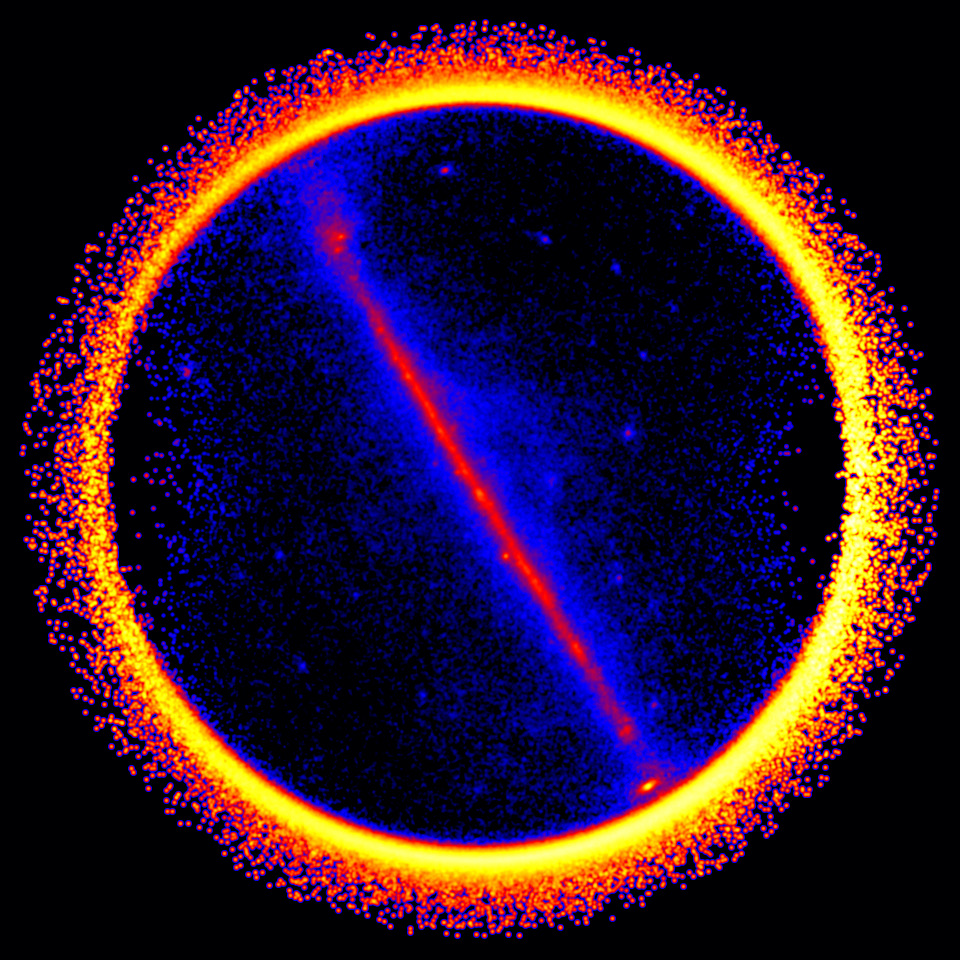
Image Credit: International Fermi Large Area Telescope Collaboration, NASA, DOE
Explanation: For an Earth-orbiting gamma-ray telescope, Earth is actually the brightest source of gamma-rays, the most energetic form of light. Gamma-rays from Earth are produced when high energy particles, cosmic rays from space, crash into the atmosphere. While that interaction blocks harmful radiation from reaching the surface, those gamma-rays dominate in this remarkable Earth and sky view from the orbiting Fermi Gamma-ray Space Telescope's Large Area Telescope. The image was constructed using only observations made when the center of our Milky Way galaxy was near the zenith, directly above the Fermi satellite. The zenith is mapped to the center of the field. The Earth and points near the nadir, directly below the satellite, are mapped to the edges of the field resulting in an Earth and all-sky projection from Fermi's orbital perspective. The color scheme shows low intensities of gamma-rays as blue and high intensities as yellowish hues on a logarithmic scale. Our fair planet's brighter gamma-ray glow floods the edges of field, the high intensity yellow ring tracing Earth's limb. Gamma-ray sources in the sky along the relatively faint Milky Way stretch diagonally across the middle. Launched June 11, 2008 to explore the high-energy Universe, this week Fermi celebrated its 2,000th day in low Earth orbit.
Astronomy Picture of the Day May 08, 2013
Earth's Major Telescopes Investigate GRB 130427A

Illustration Credit: NASA, DOE, Fermi LAT Collaboration
Explanation: A tremendous explosion has occurred in the nearby universe and major telescopes across Earth and space are investigating. Dubbed GRB 130427A, the gamma-ray burst was first detected by the Earth-orbiting Fermi and Swift satellites observing at high energies and quickly reported down to Earth. Within three minutes, the half-meter ISON telescope in New Mexico found the blast in visible light, noted its extreme brightness, and relayed more exact coordinates. Within the next few minutes, the bright optical counterpart was being tracked by several quickly re-pointable telescopes including the 2.0-meter P60 telescope in California, the 1.3-meter PAIRITEL telescope in Arizona, and the 2.0-meter Faulkes Telescope North in Hawaii. Within two hours, the 8.2-meter Gemini North telescope in Hawaii noted a redshift of 0.34, placing the explosion about 5 billion light years away -- considered nearby in cosmological terms. Previously recorded images from the RAPTOR full-sky monitors were scanned and a very bright optical counterpart -- magnitude 7.4 -- was found 50 seconds before the Swift trigger. The brightest burst in recent years, a signal from GRB 130427A has also been found in low energy radio waves by the Very Large Array (VLA) and at the highest energies ever recorded by the Fermi satellite. Neutrino, gravitational wave, and telescopes designed to detect only extremely high energy photons are checking their data for a GRB 130427A signal. Pictured in the above animation, the entire gamma-ray sky is shown becoming momentarily dominated by the intense glow of GRB 130427A. Continued tracking the optical counterpart will surely be ongoing as there is a possibility that the glow of a classic supernova will soon emerge.
Note: To see the animated images, visit the APOD's website by clicking on the image above.
Astronomy Picture of the Day May 04, 2012
Fermi Epicycles: The Vela Pulsar's Path
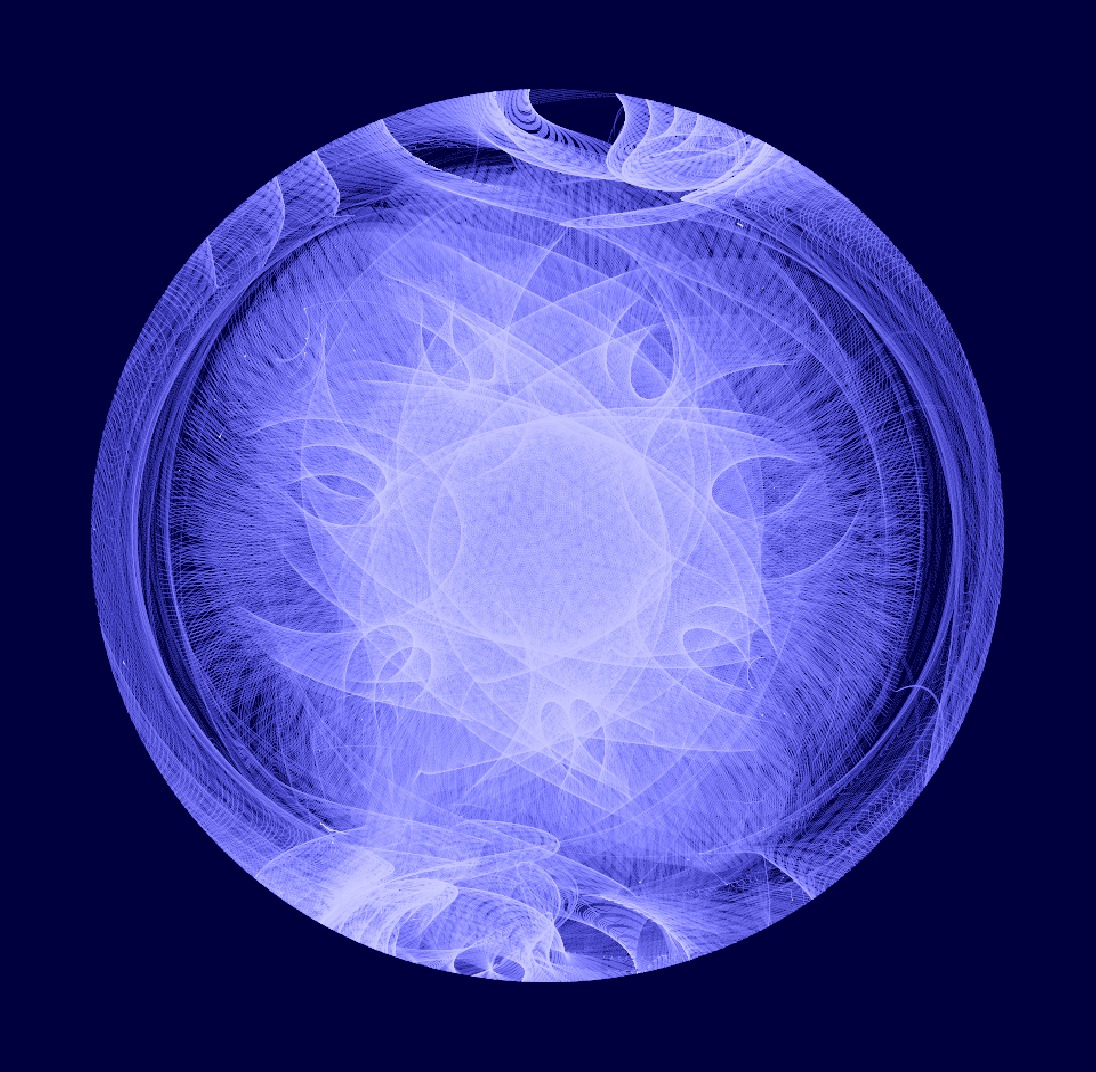
Credit: NASA, DOE, International Fermi LAT Collaboration
Explanation: Exploring the cosmos at extreme energies, the Fermi Gamma-ray Space Telescope orbits planet Earth every 95 minutes. By design, it rocks to the north and then to the south on alternate orbits in order to survey the sky with its Large Area Telescope (LAT). The spacecraft also rolls so that solar panels are kept pointed at the Sun for power, and the axis of its orbit precesses like a top, making a complete rotation once every 54 days. As a result of these multiple cycles the paths of gamma-ray sources trace out complex patterns from the spacecraft's perspective, like this mesmerising plot of the path of the Vela Pulsar. Centered on the LAT instrument's field of view, the plot spans 180 degrees and follows Vela's position from August 2008 through August 2010. The concentration near the center shows that Vela was in the sensitive region of the LAT field during much of that period. Born in the death explosion of a massive star within our Milky Way galaxy, the Vela Pulsar is a neutron star spinning 11 times a second, seen as the brightest persistent source in the gamma-ray sky.
Astronomy Picture of the Day March 15, 2012
Solar Flare in the Gamma-ray Sky

Credit: NASA, DOE, International Fermi LAT Collaboration
Explanation: What shines in the gamma-ray sky? The answer is usually the most exotic and energetic of astrophysical environments, like active galaxies powered by supermassive black holes, or incredibly dense pulsars, the spinning remnants of exploded stars. But on March 7, a powerful solar flare, one of a series of recent solar eruptions, dominated the gamma-ray sky at energies up to 1 billion times the energy of visible light photons. These two panels illustrate the intensity of that solar flare in all-sky images recorded by the orbiting Fermi Gamma-ray Space Telescope. On March 6, as on most days, the Sun was almost invisible to Fermi's imaging detectors. But during the energetic X-class flare, it became nearly 100 times brighter than even the Vela Pulsar at gamma-ray energies. Now faded in Fermi's view, the Sun will likely shine again in the gamma-ray sky as the solar activity cycle approaches its maximum.
Astronomy Picture of the Day May 23, 2011
An Unexpected Flare from the Crab Nebula

Credit: NASA, DOE, Fermi LAT, R. Buehler (SLAC, KIPAC)
Explanation: Why does the Crab Nebula flare? No one is sure. The unusual behavior, discovered over the past few years, seems only to occur in very high energy light -- gamma rays. As recently as one month ago, gamma-ray observations of the Crab Nebula by the Fermi Gamma Ray Space Telescope showed an unexpected increase in gamma-ray brightness, becoming about five times the nebula's usual gamma-ray brightness, and fading again in only a few days. Now usually the faster the variability, the smaller the region involved. This might indicate that the powerful pulsar at the center of the Crab, a compact neutron star rotating 30 times a second, is somehow involved. Specifically, speculation is centered on the changing magnetic field that surely surrounds the powerful pulsar. Rapid changes in this field might lead to waves of rapidly accelerated electrons which emit the flares, possibly in ways similar to our Sun. The above image shows how the Crab Nebula normally appears in gamma rays, as compared to the Geminga pulsar, and how it then appeared during the recent brightening.
Astronomy Picture of the Day November 10, 2010
Huge Gamma Ray Bubbles Found Around Milky Way
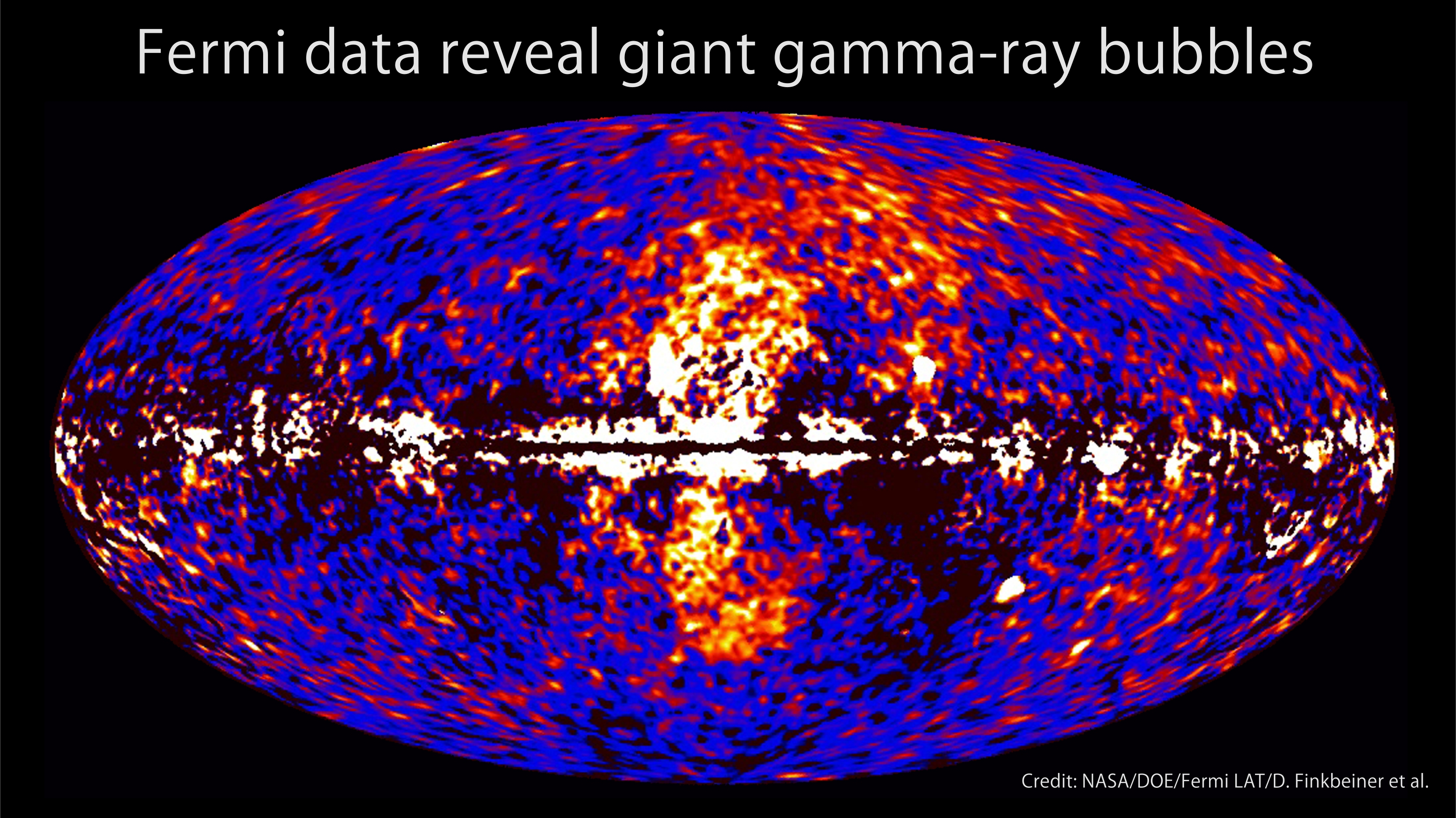
Credit: NASA, DOE, Fermi Gamma-Ray Space Telescope, LAT detector, D. Finkbeiner et al.
Explanation: Did you know that our Milky Way Galaxy has huge bubbles emitting gamma rays from the direction of the galactic center? Neither did anybody. As the data from the Earth-orbiting Fermi satellite began accumulating over the past two years, however, a large and unusual feature toward our Galaxy's center became increasingly evident. The two bubbles are visible together as the red and white spotted oval surrounding the center of the above all sky image, released yesterday. The plane of our Galaxy runs horizontally across the image center. Assuming the bubbles emanate from our Galaxy's center, the scale of the bubbles is huge, rivaling the entire Galaxy in size, and spanning about 50,000 light years from top to bottom. Earlier indications of the bubbles have been found on existing all sky maps in the radio, microwave, and X-ray. The cause of the bubbles is presently unknown, but will likely be researched for years to come.
Astronomy Picture of the Day March 18, 2010
The Fermi LAT 1FGL Source Catalog
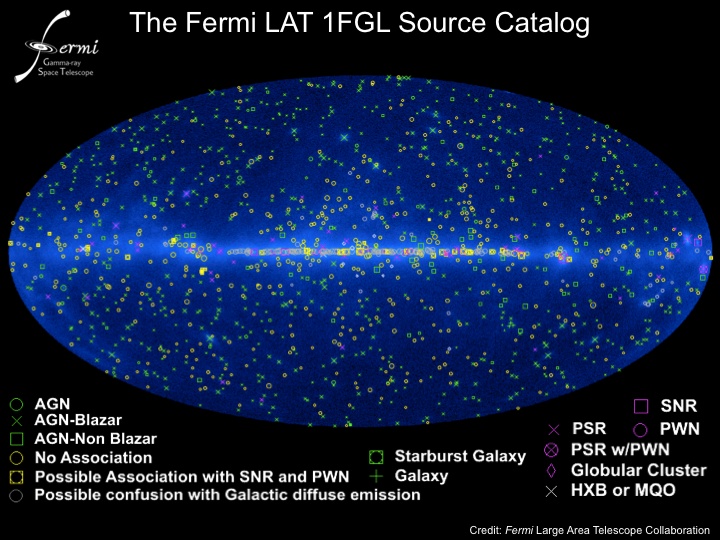
Credit: NASA, DOE, International Fermi LAT Collaboration
Explanation: What shines in the gamma-ray sky? The most complete answer yet to that question is offered by the Fermi Gamma-ray Space Telescope's first all-sky catalog. Fermi's sources of cosmic gamma-rays feature nature's most energetic particle accelerators, ultimately producing 100 MeV to 100 GeV photons, photons with more than 50 million to 50 billion times the energy of visible light. Distilled from 11 months of sky survey data using Fermi's Large Area Telescope (LAT), the 1,451 cataloged sources include energetic star burst galaxies and active galactic nuclei (AGN) far beyond the Milky Way. But within our own galaxy are many pulsars (PSR) and pulsar wind nebulae (PWN), supernova remnants (SNR), x-ray binary stars (HXB) and micro-quasars (MQO). Fermi's all sky map is shown centered on the Milky Way with the diffuse gamma-ray emission from the Galactic plane running horizontally through the frame. To locate the cataloged gamma-ray sources, just slide your cursor over the map. For now, 630 of the sources cataloged at gamma-ray energies remain otherwise unidentified, not associated with sources detected at lower energies.
Note: Click on the image to go to the APOD's website and locate the cataloged gamma-ray sources!
Astronomy Picture of the Day July 09, 2009
Fermi's Gamma-ray Pulsars

Credit: NASA, DOE, Fermi LAT Collaboration
Explanation: Born in supernovae, pulsars are spinning neutron stars, collapsed stellar cores left from the death explosions of massive stars. Traditionally identified and studied by observing their regular radio pulsations, two dozen pulsars have now been detected at extreme gamma-ray energies by the Fermi Gamma-ray Space Telescope. The detections include 16 pulsars identified by their pulsed gamma-ray emission alone. This gamma-ray all-sky map, aligned with the plane of our Milky Way Galaxy, shows the pulsar positions, with the 16 new Fermi pulsars circled in yellow (8 previously known radio pulsars are in magenta). Bizarre stellar corpses, the Vela, Crab, and Geminga pulsars on the right are the brightest ones in the gamma-ray sky. Pulsars Taz, Eel, and Rabbit are named for the nebulae they are now known to power. The Gamma Cygni and CTA 1 pulsars at the left also reside within expanding supernova remnants of the same name.
Astronomy Picture of the Day March 21, 2009
Fermi's view of the gamma-ray sky

Credit: NASA, DOE, Fermi LAT Collaboration
Explanation: Scanning the entire sky in gamma-rays, photons with over 50 million times the energy of visible light, the Fermi mission's Large Area Telescope (LAT) explores the high-energy universe. This all-sky map constructed from 3 months of LAT observations (August 4 to October 30, 2008) represents a deeper, better-resolved view of the gamma-ray sky than any previous space mission. What shines in Fermi's gamma-ray sky? A new paper describes the 205 brightest gamma-ray sources, but this map highlights a Fermi "top ten" list of five sources within, and five sources that lie beyond our Milky Way Galaxy. Within our galaxy: the Sun traces a faint arc across the map between the observation dates, LSI +61 303 is an X-ray binary star about 6,500 light-years away, PSR J1836+5925 is a type of pulsar (spinning neutron star) that is only seen to pulse at gamma-ray energies, and 47 Tuc is a globular star cluster some 15,000 light-years away. A fifth galactic source (unidentified), just above the center of the galactic plane, is intriguing because it is a variable source and has no clear counterpart at other wavelengths. Beyond our galaxy: NGC 1275 is a large galaxy at the heart of the Perseus galaxy cluster some 233 million light-years away, while 3C 454.3, PKS 1502+106, and PKS 0727-115 are active galaxies billions of light-years distant. Another unidentified source, seen below the galactic plane, is likely beyond the boundaries of the Milky Way. Its nature remains a mystery.
Astronomy Picture of the Day August 28, 2008
Fermi's First Light
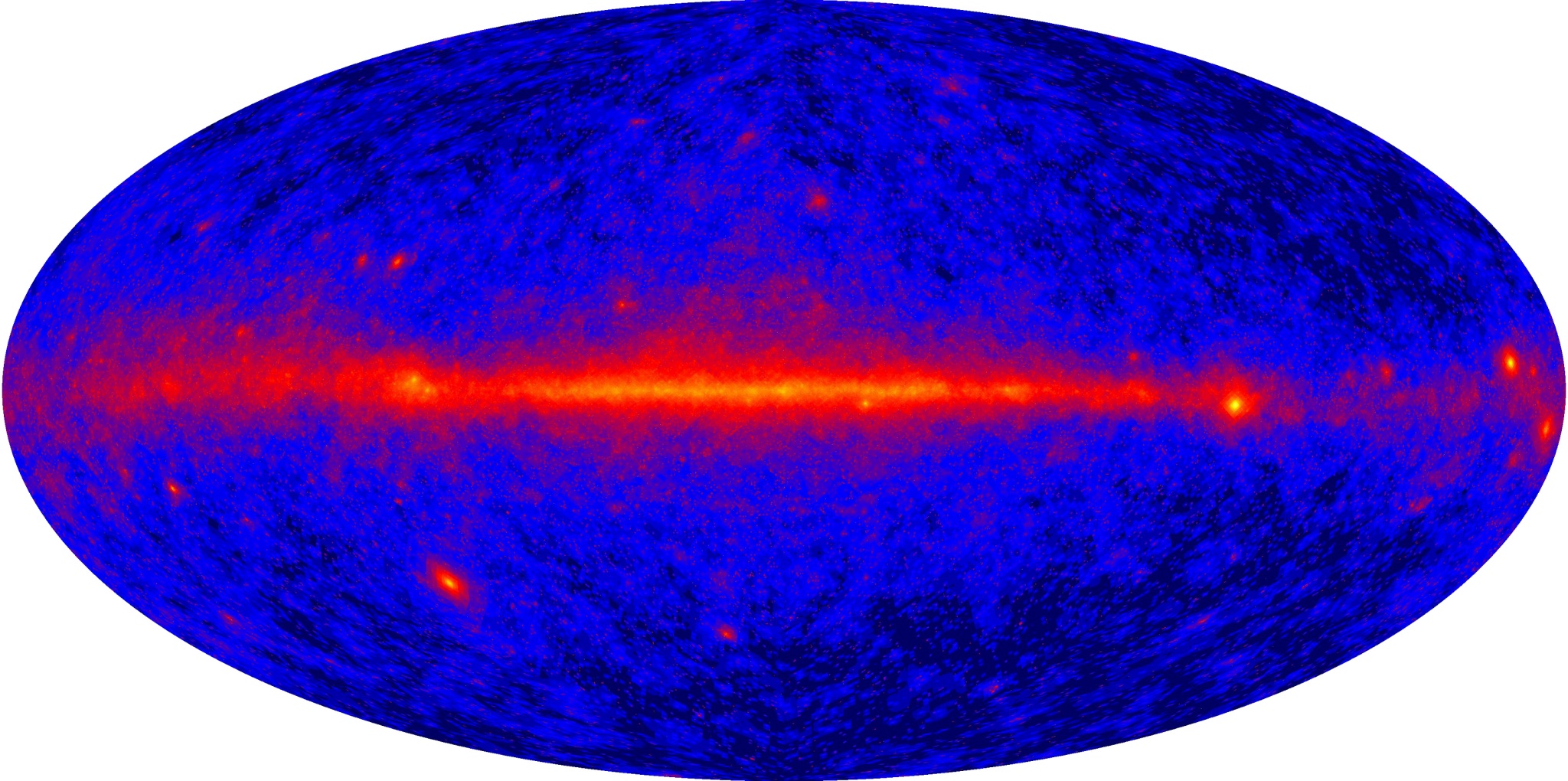
Credit: NASA, DOE, International LAT Team
Explanation: Launched on June 11 to explore the universe at extreme energies, the Gamma-ray Large Area Space Telescope has been officially renamed the Fermi Gamma-ray Space Telescope, in honor of Nobel Laureate Enrico Fermi (1901-1954), pioneer in high-energy physics. After testing, Fermi's two instruments, the Gamma-ray Burst Monitor (GBM) and the Large Area Telescope (LAT), are now regularly returning data. Fermi's first map of the gamma-ray sky from the LAT is shown in this false-color image, an all-sky view that looks toward the center of our Milky Way Galaxy with the galactic plane projected across the middle. What shines in the gamma-ray sky? Along the galactic plane, energetic cosmic rays collide with gas and dust to produce the diffuse gamma-ray glow. Strong emission from spinning neutron stars or pulsars, and distant active galaxies known as blazars, can be identified by placing your cursor over the map. A prelude to future discoveries, the remarkable result combines only 4 days of observations, equivalent to a year of observations with the Compton Gamma-ray Observatory mission of the 1990s. In addition to the ability to monitor gamma-ray bursts, the greatly improved sensitivity will allow Fermi to look deeper into the high-energy Universe.
Note: Click on the image to go to the APOD's website and identify the brightest sources in the Fermi LAT first light map!
See also the Fermi Education and Public outreach picture gallery.
![]()


